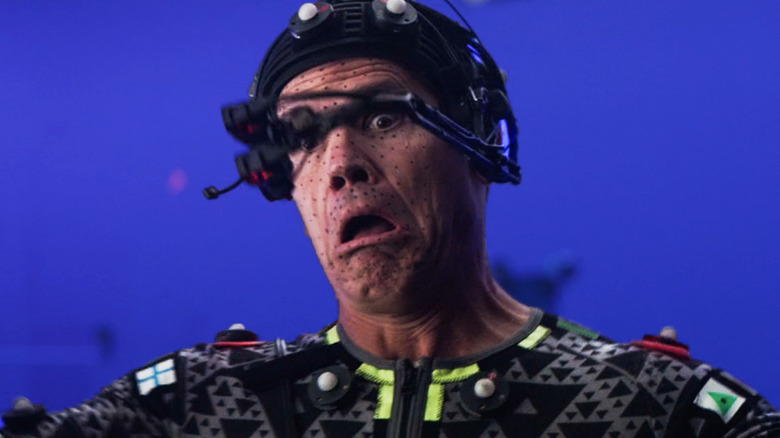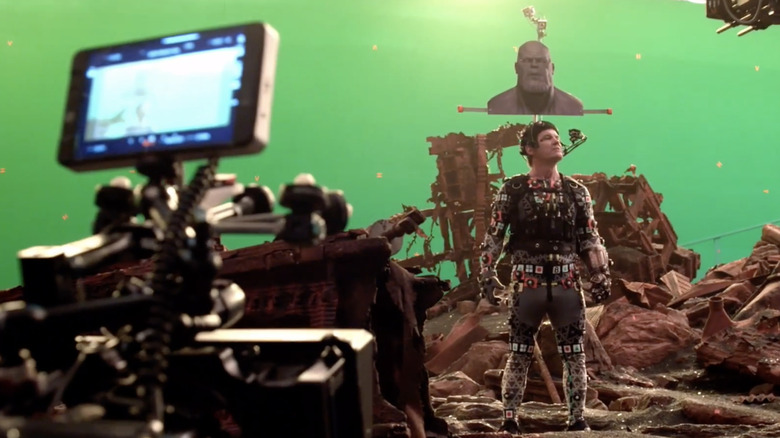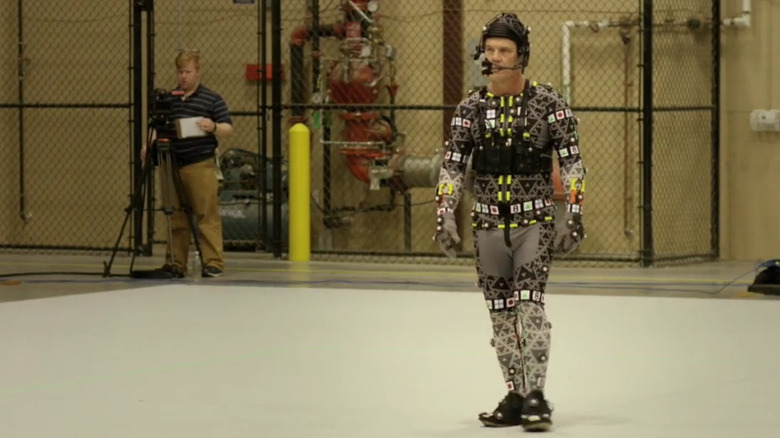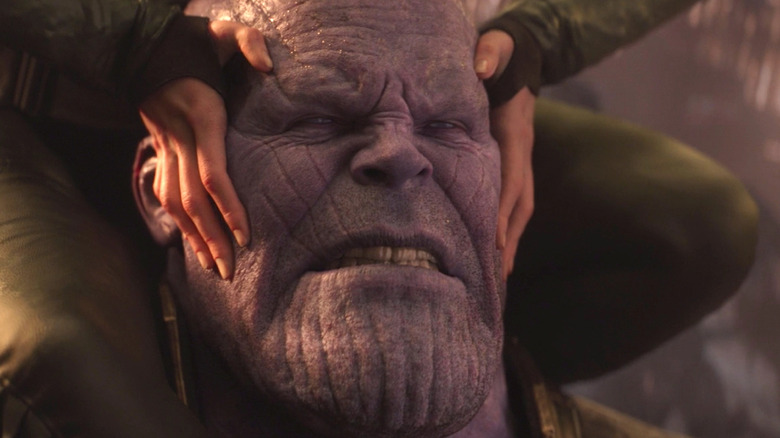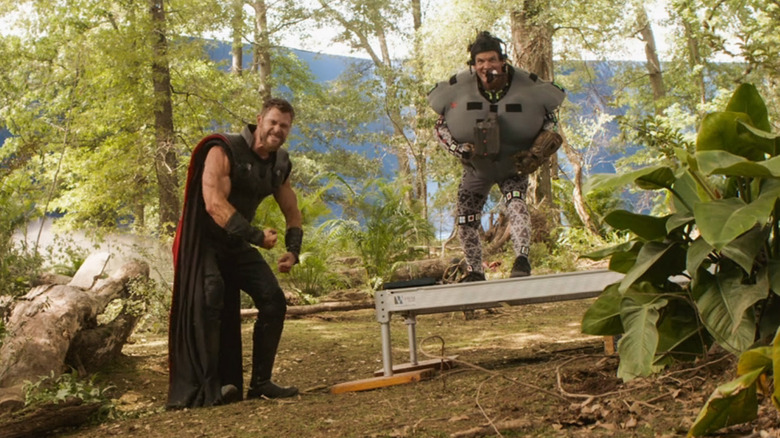Avengers: Infinity War Without CGI Makes Thanos A Little Less Terrifying
Four years after his climactic defeat, Josh Brolin's Thanos remains one of the best villains in the entire Marvel Cinematic Universe. Sure, the bar is often disappointingly low, but even when it comes to the best of the best, The Mad Titan who orchestrated the Infinity Saga is high on the list. From his towering stature and army of followers to his complex moral philosophy, he spent nearly a decade as a growing threat to Earth's mightiest defenders. Despite how hard Tony Stark prepared for an alien invasion, when Thanos finally touched down on Earth, it took two movies (and the trauma of The Blip) for them to scrape by with a win. And don't even get me started on the collateral damage.
It's also Brolin's performance that makes Thanos a next-level antagonist: this isn't villainy just for the sake of evil. He wholeheartedly believes that he can make the world a better place by, ya know, committing mass genocide and eradicating 50% of the entire universe's population. That conviction kept him moving forward and, eventually, won him his victory. There's a reason he spent the bulk of the franchise sitting around in his pretty golden chair: because once he was unleashed on the universe, all bets were off.
But what if I told you that on the set of "Avengers: Infinity Wars," there isn't anything scary about the purple warlord? In fact, when Josh Brolin is in character as the menacing genocidal brute, he looks downright hilarious. You probably could've guessed that, given we're all familiar with the prospect of actors wearing their silly little VFX dots and being screen partners with a floating tennis ball. But wait until you see just how much movie magic (aka hard work from a massive team of professionals) is required to make Thanos threatening.
The not-so-scary truth behind Thanos
Did your heart clench at the beginning of "Avengers: Infinity War," when Thanos reached down, lifted Thor by the head, and threatened to crush his skull if Loki didn't hand over an infinity stone? Well, what if instead of a hulking space alien, it was a 50-year-old actor in a colorful wet suit with a cardboard cutout of a comic book villain stapled to his back? Not so scary, huh?
As seen in an Infinity War gag reel, Brolin played his CGI-created character via motion capture and to assume the role on set, wore body and facial-capture systems to record his performance. Unsurprisingly, Brolin's entire mocap outfit is a glory to behold — but by far the best part of the get-up is that there's a nametag stapled to the back that reads "Thanos," lest anyone try to steal the purple titan's identity.
We're all familiar with the mocap wetsuit by now, and the dots that make up the facial-capture, but there's also an extra special element to Brolin's suit, to make sure his scene partners remember exactly who they should be envisioning before them. Don't let the special effects fool you, Josh Brolin is not the same size as the 8'3 galactic supervillain that he plays! To make up for the size difference, Brolin sometimes wore a backpack with a pole extending above his head, holding a cardboard cutout of Thanos. This would give his fellow actors a proper eyeline, so they'd know exactly where to look during the scene.
In other words, next time you revisit Thanos facing off against the Avengers, just pretend that Captain America isn't being punched out by a huge purple alien, but by a tiny, smiling cardboard cutout of his face.
Thanos is nothing without his onesie
Although it's generally stress-inducing to revisit the movie where Thanos decimates the entire universe and triumphs against our heroes, never forget that above all, he's just Josh Brolin in a onesie, standing on a Disney soundstage, existentially questioning his life choices.
Chatting with Total Film magazine in 2018 (via Games Radar), Brolin unpacked just how strange it was to film scenes with his fellow cast members: "I thought, 'What the f*** am I doing here?'" he laughed, explaining:
"Because you're in a onesie, man. You've got to walk around in a onesie and imagine yourself as an actor with some impact. I'm Josh, who's got dots on him, and a onesie, and a helmet-cam, and I've got Scarlett [Johansson, as Black Widow] right there, and I've got Brie [Larson, Captain Marvel], and Don Cheadle [War Machine], and [Chris] Hemsworth [Thor], and Chris Evans [Captain America], and [Robert] Downey [Iron Man]... And I'm sitting there and I'm looking like I look, which is not 700lb and purple and eight feet tall."
Thankfully, the VFX team had Brolin's back, and if not for behind-the-scenes footage, we would never know about Brolin's onesie, his Thanos cutout, or his colorful dots. Because as far as the final product is concerned, Thanos is a genocidal warlord who's physically capable of taking down The Hulk. And even though he sometimes felt a little ridiculous in the moment, Brolin didn't let the looming cardboard cutout stop him from delivering a killer performance — particularly in "Infinity War," which makes Thanos the emotional center of the movie.
Creating Thanos takes hundreds of people
"Josh Brolin brings a reality to the character," MCU executive producer Louis D'Esposito commented, in a featurette for the DVD release of the film. "He's wearing that mocap suit, he's wearing the motion capture cameras and the performance is coming through, not only in his gestures and in his face, but in his eyes."
But it takes two to tango. Sometimes, it even takes two hundred. Because fun and games aside, transforming Josh Brolin into the big bad of the MCU was no simple task. To pull it off, Marvel required the help of two visual effects houses (Digital Domain and Weta Digital) and assistance from Medusa, the facial-scanning system of a third (Industrial Light & Magic).
The Hollywood Reporter spoke with some of the VFX artists involved back in 2019, and detailed the complex process required to bring Thanos to life. The article includes VFX supervisor Kelly Port explaining that the motion capture data from set was combined with the data provided by Medusa, which would be fed into a system meant to "learn" Brolin's expressions so they could create a higher-resolution version of his performance. That would then be applied to the CGI Thanos, but it would fall to the animators to further enhance the performance by hand.
It's one thing for Thanos to engage in a big action set-piece and go toe-to-toe with the Incredible Hulk, but believe it or not, the real challenge is a scene like Thanos murdering Gamora on Vormir: a quieter and more contemplative moment that involves close-ups of his emotional reaction to his daughter's death. Those moments, which wouldn't exist without the VFX teams who pull them together, are what make Thanos such a compelling villain. Which makes the recent reports about how Marvel treats their VFX teams all the more egregious.
How much is this movie magic worth?
In the summer of 2022, there came a flurry of new stories, Reddit threads, tweets and interviews that delved into the specifics of the toxic work environment faced by VFX artists in Hollywood. Marvel came up in all of these discussions, which comes as no shock given the sheer amount of post-production required on their huge, blockbuster projects. Per THR, roughly 2,000 VFX shots across 11 vendors were required for "Doctor Strange in the Multiverse of Madness," which is just one of the six releases (three films and three Disney+ TV series) from Marvel last year.
/Film has reported on this subject in the past, but as recently as last week, a report from Vulture featured the claim from several VFX artists that Marvel tends to "pay upward of 20 percent less than other studios." Between the accelerating rate of frustration and the fact that VFX needs are only ramping up (for Marvel especially), they'll soon have to reckon with just how much they rely upon VFX artists and how terribly they've treated them in return. Otherwise, mocap onesies and cardboard cutouts might just become an MCU staple.
